The passion Flower is one of the most beautiful and amazing flowers. Two common types of Passion Fruit plants are purple and yellow. The Purple Passion Fruit plant is the most common, and the size of this fruit is slightly smaller than a Lemon. There are several hybrids of Purple Passion Fruit.
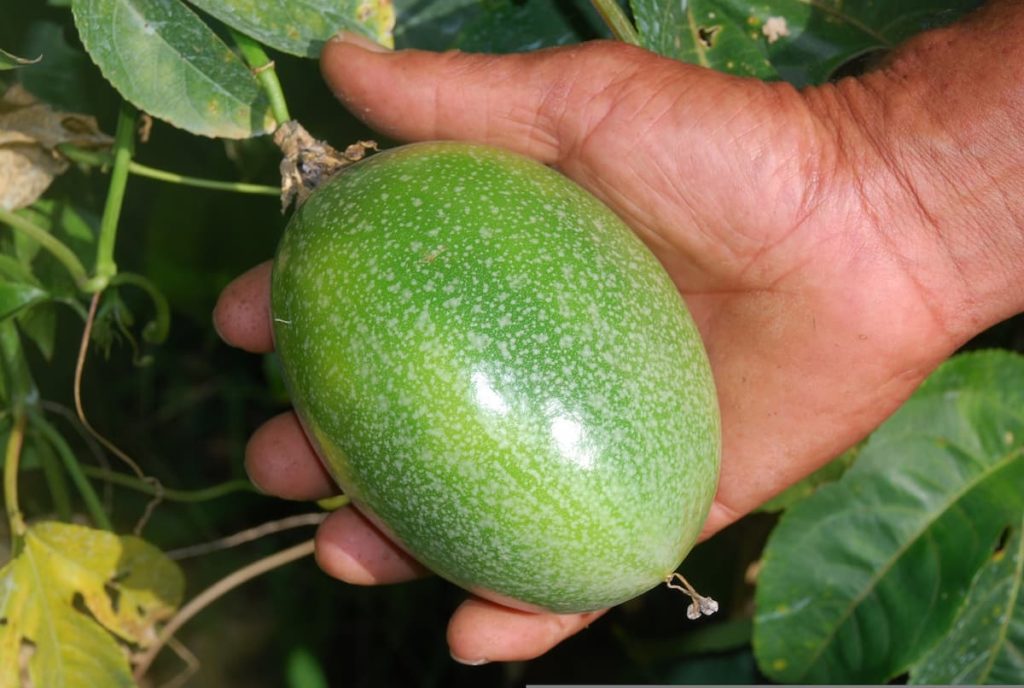
Yellow Passion Fruit is the second most widely grown after the Purple Passion Fruit. It is shiny yellow, and its fruit is the size of a grapefruit. Purple Passion Fruit is sweeter than Yellow Passion Fruit, which is also more acidic. Save the seeds of your Passion Fruit and use them to make more beautiful, bountiful vines on your property.
How to grow Passion Fruit tree from seed to harvest
Can Passion Fruit be grown from seed?
- Passion Fruit plants are one of the garden’s most popular plants. They have a short lifespan, usually about six to seven years. For this reason, it is a good idea to plant a succession of Passion Fruits.
- Passion Fruit can be grown from seeds inside ripened Passion Fruit or seedlings purchased at a gardening shop or nursery. Don’t expect seed-grown plants to bloom immediately. Some Passion Flower varieties can take up to ten years to bloom.
- Passion Fruit vines grow easily from seeds, especially in tropical or subtropical climates. They also thrive in sub-tropical areas. However, not every Passion Fruit variety comes true from the seed.
How long does it take to get fruit from Passion Fruit?
- Passion Fruit is either yellow or purple (depending on the variety), round, and about 2 to 3 inches across. It has a smooth, thick, pitchy rind filled with sweet, aromatic pulp, juices, and seeds. Passion Fruit vines climb on any support easily and quickly, climbing as high as support would allow.
- A newly planted vine can take 12 to 18 months to reach fruit size. You usually get a large crop during summer and autumn; the gardener will get a continuous crop in more tropical areas. Fruits ripen when the skin is wrinkled: pick the fruit before it drops.
- Passion Fruit usually takes 12 to 18 months to bear fruit, so if you plant your seed or seedlings in early spring, they should be ready for harvesting by early summer or fall of next year.
Should you soak Passion Fruit seeds before planting?
- You should pre-treat Passion Fruit seeds before planting. They have a hard seed coat and are very slow to sprout. There are different methods before treatment, but the easiest is to soak the seeds in warm water for 24 to 48 hours before planting.
- Passion Fruit seeds have a hard coating that can delay germination, so it’s a good idea to soak them in warm water overnight and germinate them first before planting. The next day fill a container with a seed lifting mix, sow the seeds and lightly cover them with soil.
In case you missed it: Passion Fruit Seed Germination, Period, Temperature
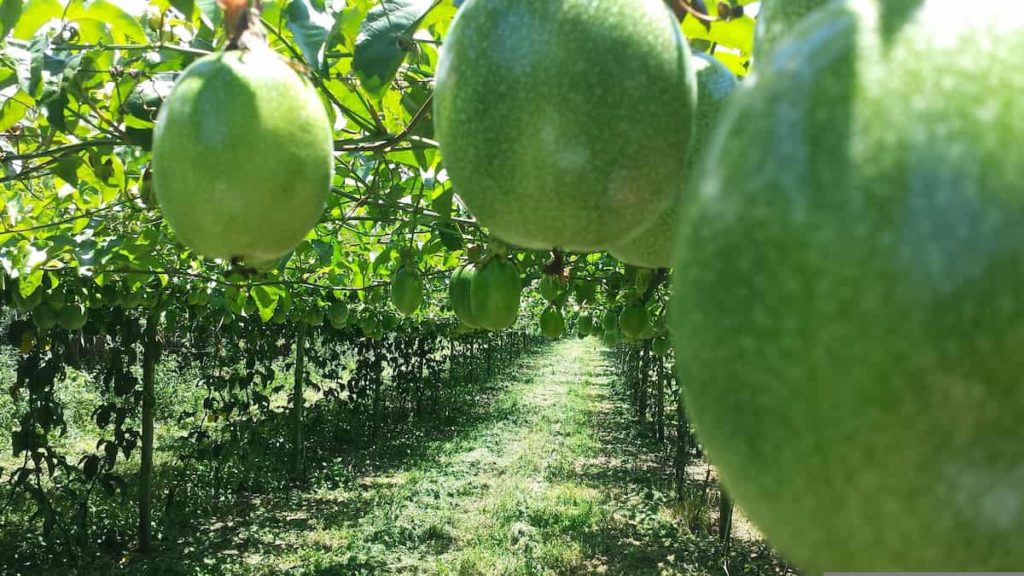
How long does it take to germinate Passion Fruit seeds?
- Choose a ripe Passion Fruit with a little crinkled rind from the grocery store, halve it, and take out its seeds. Wash any fruit pulp from your seeds and dry them with a paper towel.
- You should rub them between a sheet of sandpaper and soak them for 12 hours at night to improve the chances that your seeds will sprout. Fill a pot that is 4 inches across and have drainage holes with an all-purpose compost. Then, moisten the compost until the water comes out of the holes.
- To start the germination process, bury your seeds in a container filled with a small amount of soil or seed-raising mix about an inch deep. Sow your seed below the surface and water it to keep the soil moist. You can also use a seaweed solution to help your seeds sprout more quickly.
- Water your Passion Fruit seeds regularly to keep the soil moist but do not irrigate it. Place your container in a warm place to facilitate moisture. Wait until the seeds sprout. Regularly water your seed until it sprouts.
- Usually, germination takes 10 to 21 days if conditions are warm and the seeds are fresh. Sometimes seeds may take up to four months to sprout, so be patient.
Does Passion Fruit need full sun?
- The Passion Fruit vine is a strong, vigorous, evergreen climber. The best place for a Passion Fruit vine is one that’s out in the open, has full sun, and has no trees or competitive roots.
- Plant the Passion Fruit vines in full sun to partial shade to keep them healthy and bloom. Plants appreciate some of the afternoon shade in extremely hot climates. Passion Flowers typically require at least four to six hours of sunlight daily (or in a colder climate).
- Plant fruit vines in full sunshine except in very hot areas where partial shade is better. Vines can be rampant, so a strong trellis must be installed before planting, or you can plant along a chain link fence.
What is the best fertilizer for the Passion Fruit tree?
- A fertilizer high in nitrogen promotes leaf growth at the expense of fruits and flowers. Therefore, you are better off fertilizing with chicken manure, well-rotted cow manure, citrus foods, or compost. You can even place used tea bags at the base of established vines, allowing them to seep into the soil as fertilizer.
- In commercial settings, the suitable fertilizer for Passion Flower vine is one with an NPK ratio of 10-5-20. It gives the best vine growth and essential nutrients for many fruits.
- Passion Fruit vines thrive on any fertilizer designed to thrive and encourage fruit. Apply fertilizer in spring and every four weeks in the summer months. Always water well while applying fertilizer.
- In spring and autumn, feed your Passion Fruit vine well with chicken manure and water twice a year. You should spread the fertilizer over the entire root system. You should avoid over-feeding with nitrogen fertilizers, as this will promote leaf growth at the expense of flowers and fruits.
In case you missed it: Growing Passion Fruit in Containers from Seed, Cuttings
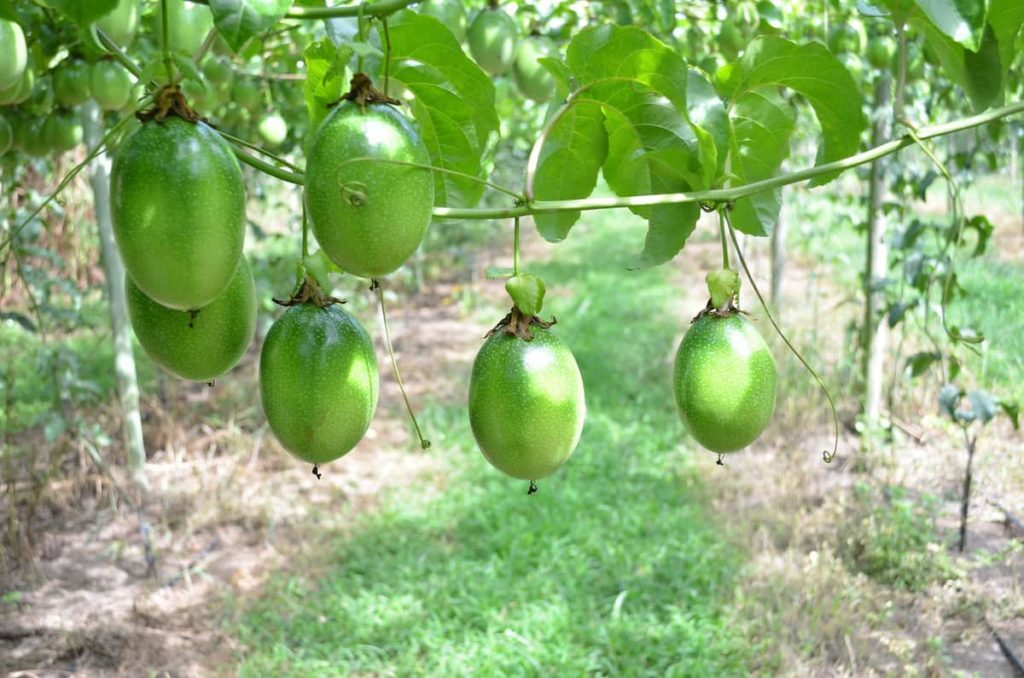
Can Passion Fruit grow in pots?
- Passion Fruit can be grown in large pots as long as a strong supporting structure, such as fences or trellis on which they can grow.
- It is easy to grow Passion Fruit vines in containers, but you will need to feed and water them more often, and they will not grow as fast as those growing in the ground. Choose a gritty, free draining, peat-free compost.
- In areas where they are not hardy, Passion Fruit plants are often grown in pots and moved indoors for winter. Usually, they should be grown in full sunlight to partial shade, on average, but in well-drained soil.
How do I protect my Passion Flower in the winter?
- Passion Flower winter care may include regular watering and keeping them active throughout the season, or Passion Flower vines can include a period of dormancy in winter. If you allow the plant to become dormant, you’ll want to keep it in a dark, dry, cool place. It will thus lose its leaves in the winter months.
- Short freeze on well-mulched plants will result in a dieback of old material but re-sprouting from the roots in the spring. Cutting the Passion vines to only 1 or 2 strong stems in old or unmaintained plants will force the plant to regrow new stems, which can then be trained.
Why does my Passion Fruit not bear fruit?
- The most common reason why the Passion Fruit does not bear fruit is the lack of pollination. This means there aren’t enough bees around to pollinate the flowers. One treatment is hand-pollinating the flowers yourself. Alternatively, planting other bee-loving locals, like Lavender, might be a good idea.
- Many of the flowers of the Purple Passion vine will establish fruit when self-pollinated, but Yellow Passion vines need to be pollinated with different vines that are genetically compatible.
- Insufficient water will stress the Passion Fruit vines, causing them to abort or not even flower. Keep the Passion Fruit vine moist regularly. Be sure to have mulch but not much water around the plant to maintain moisture, which can lead to further disease.
In case you missed it: Passion Fruit Gardening for Beginners, How To Start
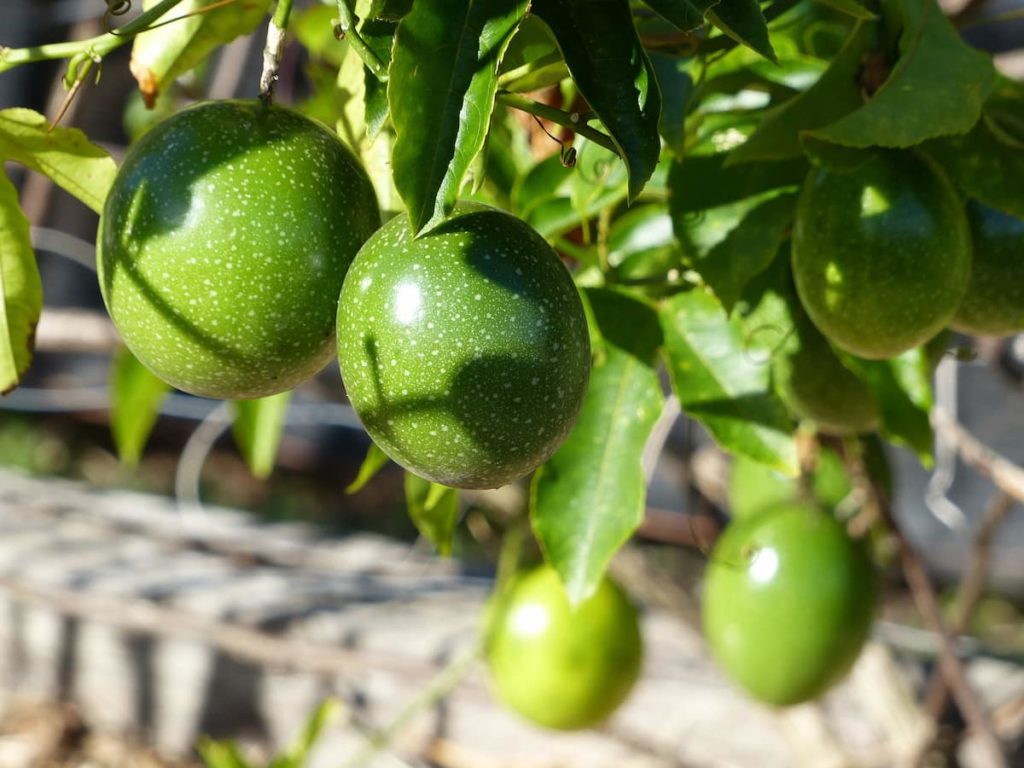
How many Passion Fruit does a plant produce?
- Vines have a production life of 3 to 4 years. Well-managed vines can produce 20 to 30 kilograms per vine per year.
- Each fruit has 250 edible seeds, and each seed is surrounded by an orange aril containing juice. The single Passion Fruit vine on the plantation will easily produce around 100 fruits yearly.
- Fruit production depends on different types, soil types, and conditions. However, with good farm management practices, you can achieve an average yield of 9 kg per hectare in the case of Purple Passion Fruit. The hybrid type yield will be high, around 16 to 8 kg per hectare.
Do you need 2 plants for Passion Fruit?
- The Passion Fruit is self-fertile, so there is no need for two vines. Make sure you feed with fertilizer high in potassium in mid-spring to encourage a set of flowers and fruits.
- The flowers of Passion Fruit are self-fertile due to the morphology of the flowers; they are structured so that the anthers are kept below the stigma. Furthermore, plants are either self-compatible or self-incompatible, depending on their types.
- Hand-pollinate your Passion Fruit to encourage the fruit-bearing process. You can use a paintbrush and collect pollen from the stamen of one flower and spread it to the pistil of another flower on the vine. Plant lavender-like fragrant flowers near your vine to attract more flies to help pollinate.
Do Passion Fruit vines need pruning?
- You don’t have to do a hard prune every year. But take off about 30 centimeters in early spring that’s ideal.
- Passion Fruit vines do not need pruning to encourage fruit, but they may need it to remove dense growth or keep the vine under control. The best time to prune out is in spring with new growth resumes. Avoid removing the main stems; just cut back unwanted twin stems.
- After the flowers arrive, prune the Passion Flowers to keep them neat and cut back a healthy bud. There is no need to cut them hard. If the plants are out of hand and need retraining, cut them back in the spring. If necessary, the Passion Flowers grown in the container can be transferred to a frost-free place for winter.
Can you pick green Passion Fruit?
- Ripest fruits will only drop from the vine, so keep the area under your plant clear to facilitate finding fruit. Fruits still on the vine and have changed from green to purple or yellow are also ripe and may be picked straight from the tree. The sweetheart variety can take 2 to 3 months to ripen in the summer. You can eat the fruit of unripe Passion, but the taste will be very tart.
In case you missed it: Passion Fruit Growing Tips, Techniques, and Secrets
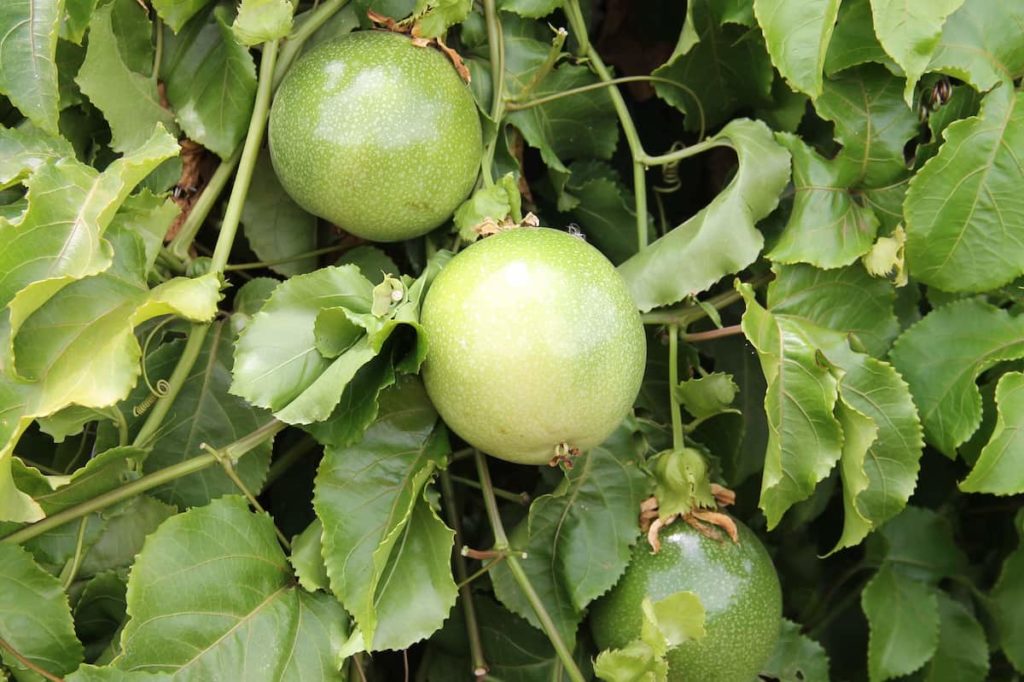
Does Passion Fruit have deep roots?
- The Passion Fruit has shallow roots, which can be prone to drying, so keep them well mulched and take care not to disturb the roots by digging or planting plants around the base.
- Passion Fruit is a deep taproot, which should be part of any transplant for best results. Plants grown from rootstock should not be transplanted, as disturbance can trigger more distressing and unproductive suckers.
- Passion Fruit vines grow an extensive root system, so make sure there’s plenty of space where you choose to plant, free of weeds, competitive plants, and grasses. They will also spread to 10 meters squared, so choose or build a structure that can accommodate it.
What kind of soil does Passion Fruit tree like?
- Passion Fruit grows best in fast-draining soil (sandy loam) with a pH of 6.5 to 7. Drainage is essential for the purple subspecies because it is prone to soil diseases. Since the roots of the plants are shallow, planting in raised beds can help provide the necessary drainage.
- Passion Fruit is best applied in free-draining soil in a sunny place in the spring when the ground is warming. Before planting, prepare your soil by adding compost and chicken manure to an area one to two meters wide. Dig a hole twice as wide and deep as the root ball, gently tease the roots, and tease the vine and water well.
How much space does a Passion Fruit vine need?
- The Passion Fruit vine grows up to 10 meters a year. You can expect the fruit after about 18 months of planting. When fruits are approaching maturity, water is needed more in Passion Fruits; if the soil is dry, the fruits can dry up and fall prematurely, so water is abundant for short periods during dry times.
- Passion Fruit vines can be big enough. They can extend to about 3 to 5 total feet in width. However, it is the height of the plant that is most impressive. It can often reach a height of 15 feet or more. The supporting structure needs to be solid to handle the weight of the vines. To make your place, put two posts, 2 meters high and 6 to 7 meters apart and in the north-south direction.
- Space young plants at a distance of 10 to 12 feet; vines will quickly fill the space in the middle. You should mulch around the base of the plant, especially in dry, hot areas, to conserve soil moisture. Mulch will also prevent stem root damage.
How do I keep bugs off my Passion Fruit?
- Select disease-resistant vines types. Remove and dispose of any diseased fruit. Prune the disease vine to increase air circulation. Apply a copper-based fungicide. Sap-sucking Passion vines hoppers can significantly reduce production if they are present in large numbers. Mealybugs can become unsightly worms on the fruit, and aphids can gently attack new shoots. Spray with neem oil to prevent them all.
How often should I water Passion Fruit?
- These vines grow fast and produce juicy fruits, so they need water. Water them regularly so that the soil does not dry. You may need to give extra water when the plants are fruity and low during autumn and winter. However, don’t have much water, which can lead to root problems.
- Passion Fruit vines are susceptible to flooding, and if flooded for more than a few days, their roots can die from a lack of oxygen.
- Passion Fruit vines need regular water, especially when the vine is young, flowery, and fruity. Depending on weather conditions and climate, you should water deeply once or twice a week. Remember to spread your water over the entire root system, not just around the vine’s trunk.
- Passion Fruit vines are heavy feeders, and they need a lot of water. A dry plant will not produce fruit, so make sure the soil is moist. Heavy rains during the flowering phase can ruin pollen viability and cause a shortage of bees for pollination.
When should I plant my Passion Fruit?
- You can plant Passion Fruit between mid-spring, mid-summer, or even after. Plant vine next to a sheltered wall, trails, or wind-sheltered deck. If more than one plant is planted, space vines do not have a distance of fewer than two meters.
- The yellow-fruited vine blooms from April to November, while the purple flower blooms from March to April. The fruit can be expected to ripen 70 to 80 days after pollination. This means Passion Fruit harvesting is around the end of summer into fall for Purple Passion Fruit vines and maybe through winter for yellow forms.
In case you missed it: How to Grow a Pineapple from Crown/Top to Harvest: Check How this Guide Helps Beginners

How do you know when Passion Fruit is ready to pick?
- You’ll find that it’s harvest time when the fruits are plump and fully colored. The color is deeply golden in yellow, and purple fruits are almost black. A slightly wrinkled fruit is super ripe and will taste sweeter than smooth-skinned Passion Fruit.
- When they are ready for harvesting, purple varieties fall to the ground, meaning the fruit needs to be collected from the ground in the middle of the rows at least once daily during harvesting. For some areas, harvesting can occur in 10 months of the year with a series of peaks in volume.
- Passion Fruit is most ripe when it’s all wrinkly and has a dark purple or dark yellow-red. The green Passion Fruit is ripening and can be left on the counter for 3 to 7 days to ripen.
Do you need a trellis for Passion Fruit?
- The important thing to remember about Passion Fruit is that it loves warmth. It’s a vine, so something like a trellis or wire will be needed to grow.
- Passion Fruit vining plants can grow up to 30 to 40 feet. The Trellis system is most suitable for the commercial production of Passion Fruit. However, it can also be used in your home garden.
- Train Passion Fruit to grow along your fence, on a wooden or wire trellis, or top of an Arbor. Ideally, they should be tall enough to provide a trellis height of 5 feet with 18 to 30 inches in the ground. You should orient trellis rows north-south for maximum exposure to sunlight, and vines should be allowed to grow together along the trellis to promote cross-pollination.
Conclusion
It is easy to grow Passion Fruit from the seed, and it is very satisfying to see that a seed-grown Passion Fruit plant grows in a large fruit-bearing vine. You can also buy various Passion Fruit seeds online, including Purple Passion Fruit, tropical Passion Fruit, or Banana Passion Fruit. It is also possible to purchase Passion Fruit plants from nurseries or specialized gardening centers if you do not have the patience to grow seeds.
- Broccoli Seed Germination and Selection
- Asparagus Seed Germination and Variety Selection
- Seasonal Flower Gardening: Best Practices for Spring, Summer, Fall, and Winter
- How to Grow Hibiscus from Flower
- Plantation Ideas for Home Decoration: A Beginners Guide
- Flower Garden Designs and Layouts for Beginners
- Planting and Spacing Techniques in Papaya: A Beginner’s Guide
- Growing Gold: Essential Techniques for Planting Pineapples
- How to Make Kalanchoe Plant Bushy: Home Remedies and Solutions
- 11 Reasons Why Your Gardenia is Not Blooming: Home Remedies and Solutions
- Eco Elegance: The Guide to Designing a Drought-Tolerant Landscape
- Gardening on a Slope: Strategies for Hillside Landscaping
- Nourish and Flourish: Top Organic Mulches for Thriving House Plants
- Everything You Want to Know about Indian Mogra Flower: Discover Uses and Growing
- Green Thumb Success: Expert Tips for Cultivating Greenhouse Pumpkins All Year Round
- Maximize Growth & Flavor: The Ultimate Guide to Companion Planting in Herb Gardens
- How to Control Rhododendron Problems Naturally: Home Remedies and Organic Ways to Fix Them
- Natural Magic: The Remarkable Benefits of Cinnamon for Plants
- Best Steps to Revive Dying Tulip with Natural and Organic Treatment
- 10 Reasons Why Your Angel Trumpet is Not Blooming: Remedies and Treatment
- How to Fix Periwinkle Leaf and Flower-Related Problems: Natural Remedies and Solutions
- How to Fix Zinnias Leaf and Flower Problems: Discover Natural and Home Remedies
- Organic Steps to Induce Lemon Tree Flowers: A Comprehensive Guide
- Bloom Booster: Crafting the Perfect Homemade Bougainvillea Fertilizer
- Optimizing Growth: A Guide to Applying NPK Fertilizer for Potted Plants
- 10 Best Homemade Fertilizers for Rubber Plant: DIY Recipes and Application Method
- How to Boost Female Pumpkin Flowers: Effective Steps for More Flowers and High Yields
- Transform Your Indoor Garden: Top Benefits of Pink Salt for Houseplants
- 10 Best Homemade Fertilizers for Peacock Plants (Calathea): Easy DIY Guide
- Unlock Blooms: 9 Reasons Why Your Potted Chrysanthemum is Not Blooming
- 8 Reasons Why Your Potted Hibiscus is Not Blooming: Fix it with Simple Solutions
- Unlock Blooms: 9 Key Reasons Your Potted Frangipani Won’t Flower
- 10 Reasons Why Is My Ice Plant Not Blooming: Remedies and Treatment
- 10 Reasons Why My Potted Hydrangea Not Blooming: Treatment and Remedies
- 10 Reasons Why is My Wisteria Not Blooming: Remedies and Treatment
- 10 Reasons Why is My Goldfish Plant Not Blooming: Remedies and Treatment